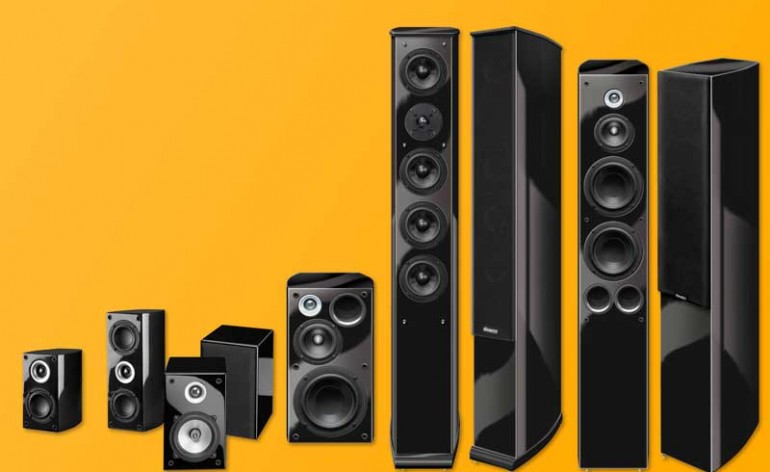Upgrade Your Speakers Hassle-free
I get asked a lot about, “Which speaker should I upgrade first?” or “Do I purchase a new subwoofer or center channel before upgrading my main speakers?” Actually, there are some really fun and intelligent ways to upgrade your speakers that will allow you to get the most out of your AV system and not break the bank. We recommend the following order for taking your home theater from one level to the next—barring you winning the lottery, of course. Then, we’d just suggest you buy the best you can and sit back and enjoy surround sound bliss immediately.
For the rest of us, though, here is a step-by-step guide to upgrade your speakers in your home theater.
Starting Small is OK, but You Can’t Upgrade Proprietary Components
While we always recommend going “big”, it’s OK to start small when upgrading your speakers. A lot of smaller systems, however, feature proprietary connections or don’t include the required connections or flexibility for later expansion. For this reason, we always recommend going with an AV receiver and speakers that are fairly “standard”. And by that we mean that they utilize an AV receiver with speaker outputs for front, center, and left and right surround speakers. We also want to see a line-level (RCA) subwoofer output that works with an active (powered) subwoofer. If you have this, then you can upgrade both the surround receiver and the speakers in any manner you wish without having to replace the entire system.
Once that’s out of the way, all that’s left is the order in which you upgrade your components. For that we have a recommended system as well.
Upgrade Your Speakers Starting with the Mains First
Since any main left/right speaker will function well as a surround speaker, it almost always makes sense to upgrade your front speakers before anything else. That way, if your system came (as many do) with slightly better front speakers than surround speakers, you get an upgrade in your surrounds as well. Feel free to hold onto those surround speakers for later use in the garage or an office, too. Once you eventually upgrade your system, you’ll find that you may be able to set up a system using the “leftovers” and get audio going in another room. Here are a couple of guidelines for upgrading your main speakers:
- When you’re upgrading your main or front speakers, don’t feel the need to match brands to your existing system. Mixing and matching is perfectly acceptable (and highly recommended) in the home theater world. The best AV receiver manufacturers don’t make the best speakers. And the best loudspeaker manufacturers don’t necessarily make the best subwoofers. You get the idea.
- Go big or go home. If you aren’t doing a significant upgrade to your main speakers, hold off. You want to wait until you can really improve the sound, not simply tweak it a little bit.
- Listen to your center channel. After an upgrade it’s likely your center channel won’t have the same timbre (sonic signature) as your new left/right main speakers. While that’s not tragic, you may be able to float this period of time by “ghosting” the center channel. We only recommend this when the center channel sound is actually detrimental to the listening experience. Ghosting the center is when you tell your AV receiver (in the setup menu) that there is no center channel speaker. It will then send dialogue and center speaker information to the left and right speakers. See our article on Where Do I Place My Speakers? to make sure your main speakers are properly toed-in for the best sound.
Upgrade the Subwoofer—You Won’t Regret It!
For years we’ve heard people say that the center channel is the most important speaker in your AV system. Hogwash. While a lot of what you hear comes through the center channel (dialogue, centered effects, etc) I have yet to hear anyone tell me, “Wow, that center channel is awesome!” I do, however, tell me they feel like they are being punched in the gut when my subwoofer accurately depicts a massive explosion. And a good subwoofer will make the kick drum and bass guitar in music, or the percussion hits in orchestral soundtracks absolutely come alive. Always upgrade your subwoofer after your main speakers.
When upgrading the sub, realize that for most rooms, anything under 8-inches really isn’t going to be an upgrade. If you’re going to do it, wait until you can afford a 10-inch or 12-inch model. Right now, those are the sweet-spot sizes for ultra-low bass response and a good amount of output. We have other articles that talk about different subwoofer types but suffice it to say, you want to go big or go home. Just how big will depend on your budget and the size of your room. Putting a 15-inch subwoofer into an 8′ x 10′ room would be ludicrous (and probably sound bad). On the other hand, upgrading your home theater-in-a-box 6.5-inch bass module to a single 10-inch sub in your 3000 cubic square foot listening space that’s open to your kitchen and dining room probably won’t give you the punch you want either. Here are some good general rules to follow:
- In a small room (anything less than 1,500 cubic feet) go with something that will net you enough output to fill the space. Typically, this will be a decent quality 10-inch subwoofer with at least 250 watts of RMS power. Specs vary from manufacturer to manufacturer so pay particular attention to the claimed reference output levels. Those should be able to tell you how loud the sub will play before encountering distortion.
- In a medium-sized room (1,500 to 3,000 cubic feet) you really want to step up to either a 12-inch subwoofer or two subwoofers of at least that size. On the upper end of this scale, it would not be absurd to want a 15-inch subwoofer or a pair of 12-inch subs to fill the space and even out the bass peaks.
- For a large room over 3,000 cubic feet, you will want to put as much bass in as possible. Simply put, that’s a lot of space to fill and a single sub will likely not cut it if you want distortion-free room-filling bass that isn’t terribly peaky.
Now Upgrade Your Center Channel Speaker
We didn’t mean to leave your center channel speaker alone forever, we just felt the subwoofer would have more impact…um, literally. But once that’s upgraded you should match a center channel to your main speakers. I like to keep the timbre the same, which means I want a center channel that uses the same tweeter, at least, as my main speakers. That will yield a more consistent sound during pans and left or right sweeps. It’s also important to make sure you get a center channel speaker that doesn’t have issues with lobing, a condition whereby the sound drops way down when you move left to right. You want a center speaker that puts out a nice, smooth area of sound in front of it that lets more than one person enjoy the music or movies.
The center channel is important, so don’t skimp here. You want your movie dialogue to be very intelligible and clean. Stay away from anything designed with a funky configuration (like with the tweeters on the outside of the speaker) as this will likely result in uneven sound and an unpredictable speaker response.
Upgrade Your Surround Speakers Last—But Don’t Forget Them!
Don’t forget your surrounds! Since virtually any speaker can be used as a surround sound speaker, we tend to recommend upgrading these last, but that doesn’t make them unimportant. In fact, the surround speakers can be the difference between experiencing a true diffuse movie-going experience and one where your surrounds are merely distracting you from the action taking place on the screen. A good pair of surround sound speakers, for movie-watching, will help envelope you into the action rather than take you out of it. For multi-channel music, your rear speakers are even more important and need to be every bit as capable as your main speakers.
Surround Back/Atmos Speakers in Your Future?
Once you have upgraded your system to a rejuvenated 5.1, it may be time to consider adding those surround back or Atmos speakers you held off on or couldn’t support early on in your system building process. With 7.1.2 or 5.1.4 you can really accentuate your music and you can also experience more discrete surround effects, with the rear channels supplying a much-needed aspect of “from behind” surround sound effects and Atmos providing height information.
When it’s time to upgrade, follow these steps and you’re sure to not go wrong in upgrading your system gradually over time. Of course, if you come into money suddenly and want to upgrade your entire system, then this article won’t be of much use—but it all and perhaps spend your money in priority order of this article.
Whether it’s new main speakers or a subwoofer upgrade, one of the greatest things you can do for your home theater is to build upon your system and raise the bar in your movie-watching or music-listening experience.
Disagree with any of our recommendations? Let us know your opinion on Facebook or comment below and join in the discussion.







Nice article, thanks for sharing. I have recently upgraded my HT 5.1 (YHT-196). Front speakers to bookshelf (Boston Acoustic A26) and center to Boston Acoustic 225C. rear (surround) speakers are small satellite speakers. what I noticed after some time, I rarely noticed voice from rear speakers. Any comment/suggestion on this.
I am using a YAMAHA RX685 Dolby Atmos AVR., A 100 W Yamaha Central Speaker, POLK S15 Front speakers (Each 100w).,Dolby Atmos enabled ONKYO Speakers as Front height speakers. But my surround speakers are Small 80W Still which I haven’t upgraded. I feel like my ATMOS Contents are not justified. Does this need to be upgraded ?
Have you taken the time to really balance the mix in your existing speakers using an SPL meter? The wattage rating of a speaker doesn’t really mean as much as the tonality and levels so that you get as much of an even mix across the different soundstages as possible (front to back, left to right, etc).